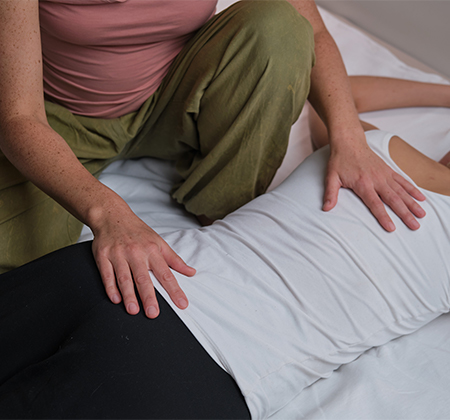 Some things can’t be talked about.
Some things can’t be talked about.
The things that have happened to us stay with us.
It’s like a paper bag that you have squished together. You can flatten it back out, but the lines are still there. The tissue remembers any trauma that’s happened.
Whether happy, scared, or sad, you felt that emotion and held your body in a certain position. Maybe if you were frightened, you were cowering… sad, your head dropped… happy, your heart is open.
Any injuries that have happened, the nervous system has locked those memories inside.
When a practitioner touches those areas…
Unexplainable emotions and sensations may arise.
You may spontaneously remember the memory of the trauma. Sometimes these memories have been covered very deeply in our subconscious. Too painful to feel, too painful to acknowledge, our bodies decide that perhaps it is just better to hold this position.
If I can’t turn my neck, I never have to pay attention or see what I don’t want to see.
If I hold my stomach tight and my legs contract, I will never be caught off guard again.
If I collapse my chest, maybe they won’t see me and cannot hurt my heart again. Our body creates a safe container the best that it can.
 To fully heal, we often need to feel things.
To fully heal, we often need to feel things.
Touch can bring up many things, including pleasure, fear, comfort, pain, sadness, and embarrassment.
As we move to more integrated beings, we become more aware of the parts of us that are sad, alone, and scared.
As a practitioner touches or stretches an area contracted and, at this point, almost seems like an injury or handicap, a rush of memories and sadness flows out. It’s almost like experiencing deja vu.
As a person on the massage table, as the practitioner held my skull, I could feel the years of tension in my neck and the attachments. My traps were like cement.
I remembered all the times I had been scared to my bones, hoping for dear life I would survive. I remembered an abusive boyfriend from the past. I could feel how I would crawl into a ball when he yelled at me. As I felt that in my system, the memories flooded in.
Ten years later, I was able to mourn what happened. It was all survival then. I made my body like a fortress. Now, it’s okay to relax. It’s okay to release.
I’m safe now. Safe enough to feel, safe enough to cry, safe enough to tell someone, and safe enough to have support.
 Here’s what it looks like…
Here’s what it looks like…
There are different kinds of somatic therapy, but they’re all done fully clothed and with psychotherapy.
Some clients may arrive knowing they have stuff they would like to resolve with their bodies. For example, “frozen shoulder” is often an interesting ailment that connects to many different emotional pieces in my experience, such as intense TMJ dysfunction, chronic postural patterns.
Some people may have body shame – like they hate their legs or stomach and cannot be touched there without a lot of emotional pain coming up.
Other clients may notice that they hold their anxiety in their chest or stomach and may want to explore touch there.
Another client may be completely exhausted, burnt out, and needs to rest and feel into their body. Things may come up, and we may discover some memories or “noticings,” but ultimately, the time is for their rest and reintegration.
In terms of psychotherapy (talking, expressing) and bodywork, there are a few options. Some may decide that they would like to split up their session. For instance, a little tablework and a little time talking in the chair. Perhaps one week, you want to talk. Another week, bodywork feels more appropriate. Some clients like to talk and share what they are noticing on the table. There is always some discussion and reintegration to process what it was like and what came up.
 Craniosacral Therapy
Craniosacral Therapy
Craniosacral treatment, developed from an osteopathic tradition, often centers on the spine and skull.
I’ll use a light touch with long holds to feel the rhythm of your cerebral spinal fluid. The goal is to slow down that rhythm.
This modality can be profoundly relaxing and is often used for spinal injuries, headaches, and TMJ.
Polarity Therapy
Inspired by his interest in Ayurveda and Chinese Medicine, Randolph Stone created Polarity Therapy to combine somatic therapy, nutrition, counseling, and movement. These sessions feature three different touches: a light touch, a yang touch (rocking), and a yin touch (deep). Reflexes are used to work on different areas of the physical, emotional, and spiritual body.
Stone believed there were five different energy fields in the body besides the chakras. These meridians connect to different areas of the body, relate to certain emotions, and have different functions. For instance, a client experiencing a lot of fear and anxiety may benefit from an Earth balancing session, including tailbone/sacrum work, knees, neck, and the little toe.
Acupressure
Also, from Chinese medicine, acupressure addresses different places on the body along different meridians. Each meridian and acupressure point affects the body, mind, and spirit differently. With acupressure, the bladder and kidney meridian run down the back, the back of the leg, and to the little toe. This is considered the water element and relates to fear and willpower, wisdom, insight, and intuition, the winter season representing introspection and rest, and Yin energy.
Acupressure uses lighter touches like those in Jin Shin Do (“the way of the compassionate spirit”).
Sessions are very relaxing and nurturing and address specific physical or mental ailments.
Trauma-Informed Bodywork
Some people with a history of trauma struggle with traditional Swedish massage. They may feel triggered when touched in certain areas.
With trauma-informed bodywork, we create a session tailored specifically to you. It’s an integrated massage with elements from craniosacral therapy, myofascial release, and talk therapy.
These sessions go beyond regular stress relief and into exploration and healing of your relationship with your trauma and your body.
Try something different.
You are sick of talk therapy and know you need something different. Take the next step toward a more integrated, healed, happy life.
Call today for a 15-minute consultation: (512) 522-5803. On the call, we can talk about what modalities may be right for you and what you want to work on.

